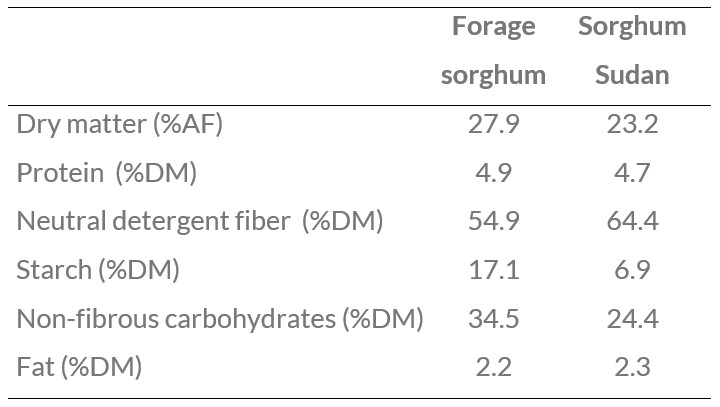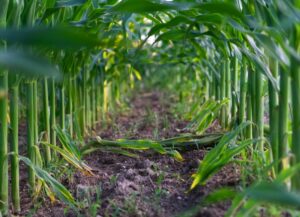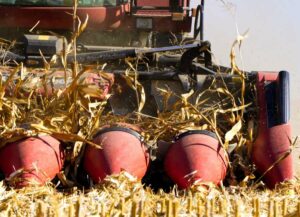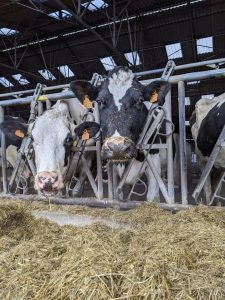Mercedes González
Sorghum is a cereal that is frequently used in the feeding of dairy cows in the form of grain and forage, although it has a lower nutritional value compared to corn. It is often used as silage, mainly grown in areas where rainfall is scarce or irrigation is limited, which make corn cultivation less profitable since it requires more water.
Sorghum is a tropical plant with high tolerance to heat and drought since it captures water more efficiently than corn. While in many areas water availability is limited due to droughts, there is still the need to grow cereal grains. In addition, quality forage must still be fed to cows even where the access of corn for forage is also limited.
Compared to corn, sorghum yields less grain, contains less starch, has more neutral detergent fiber, and its digestibility is lower than that of corn.
There are many varieties of forage sorghums, and they are classified in two large groups, multiple-cut sorghums (including Sudan grass and sorghum bicolor), and single-cut sorghums, which include classic sugar sorghums with or without grain for silage conservation.
A group of researchers (Fernandes et al., 2020) designed a sorghum experiment to study the effects of different varieties (Forage sorghum or Sorghum Sudan), their optimum storage time and fermentation profile, dry matter (DM) losses, and differences in the nutritional composition of the silage.
Five hybrids were sown from each of the two sorghum types (Forage sorghum or Sorghum Sudan). The entire plants were then harvested mature at 96 days, chopped to 16 mm, and ensiled for 15, 30 and 90 days. The nutritional composition of the fresh forage samples is in table 1.
Table 1. Nutritional composition of Sudan forage and grass varieties prior to ensiling.
The effects of sorghum variety (Forage sorghum or Sorghum Sudan) and the duration of the preservation on the microbial population and DM losses were as follows: before ensiling yeast counts were higher in Sorghum Sudan (7.42 log cfu/g) than in Forage sorghum (6.90 log cfu/g). By day 30 however the effect had reversed (3.27 log cfu/g in Forage sorghum versus 3.02 log cfu/g in sorghum Sudan).
Changes in the nutritional composition of sorghum silage
Forage sorghum showed greater DM losses (3.34%) than sorghum Sudan (2.78%) by day 90, although there were no differences at previous preservation points in time, there was a linear DM loss observed as preservation time increased.
Forage sorghum had higher DM, starch and protein prior to ensiling (table 1), and the same result was observed at the end of the ensiling period (day 90): the DM content (26.5%) and starch (10.5%) were superior in Forage sorghum, than in sorghum Sudan. Protein content was 5.64% in Forage sorghum and 4.23% in sorghum Sudan.
Protein concentration increased during ensiling and was higher in Forage sorghum (4.94% on day 15, 5.34% on day 30 and 5.64% on day 90) than in sorghum Sudan (4.83% on day 15, 4.65% on day 30 and 4.23% on day 90), although the differences observed on day 15 were not statistically significant.
The concentration of lactic acid was higher in sorghum Sudan than in Forage sorghum throughout the ensiling period until the day 90, where it reached 7.11% vs 6.20% in Forage sorghum. Sorghum silage is high in water-soluble carbohydrates, which promote the growth of lactic acid bacteria, responsible for lowering the pH.
In addition, sorghum silage has little buffering capacity, so pH reduction is often rapid in the early stages of the conservation process. The observed differences in lactic acid concentration between Forage sorghum and sorghum Sudan could be due to variations in the epiphytic species of lactic acid bacteria.
Conclusión
This study concluded that the duration of silage conservation from days 15 to 90 linearly increased the digestibility of starch in both sorghum varieties, so that increasing the time ensiled can be a useful way to improve starch utilization in cows fed sorghum silage.
Reference
Tatiane Fernandes, Eduardo Marostegan Paula, Halima Sultana, Luiz Felipe Ferraretto. Short communication: Influence of sorghum cultivar, ensiling storage length, and microbial inoculation on fermentation profile, N fractions, ruminal in situ starch disappearance and aerobic stability of whole-plant sorghum silage. Animal Feed Science and Technology. 2020 Aug; 266: 114535.
© 2021 Dairy Knowledge Center. All Rights Reserved.









